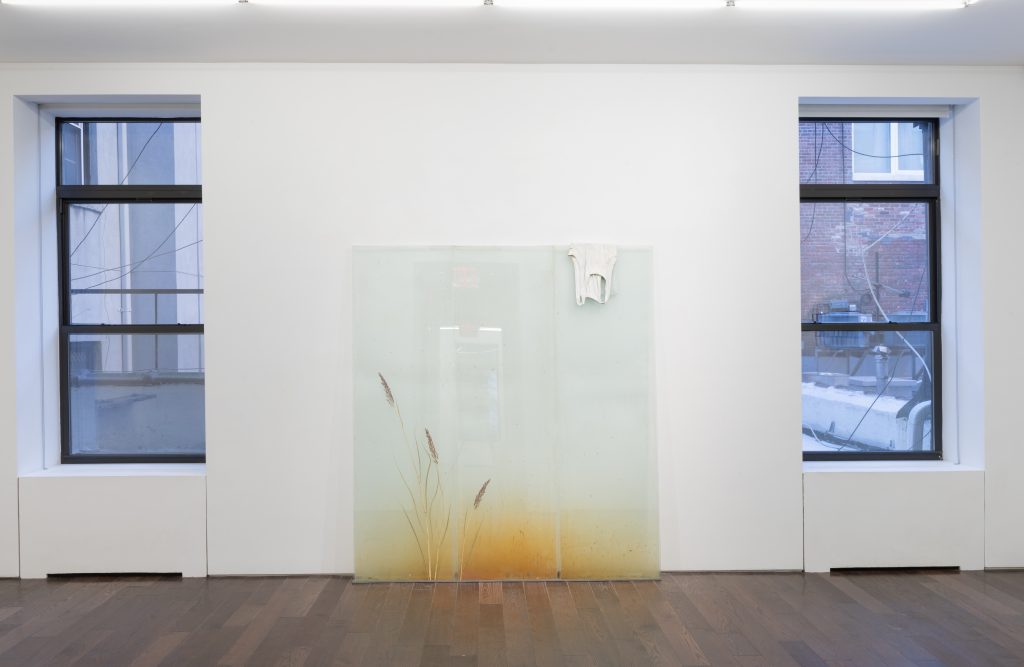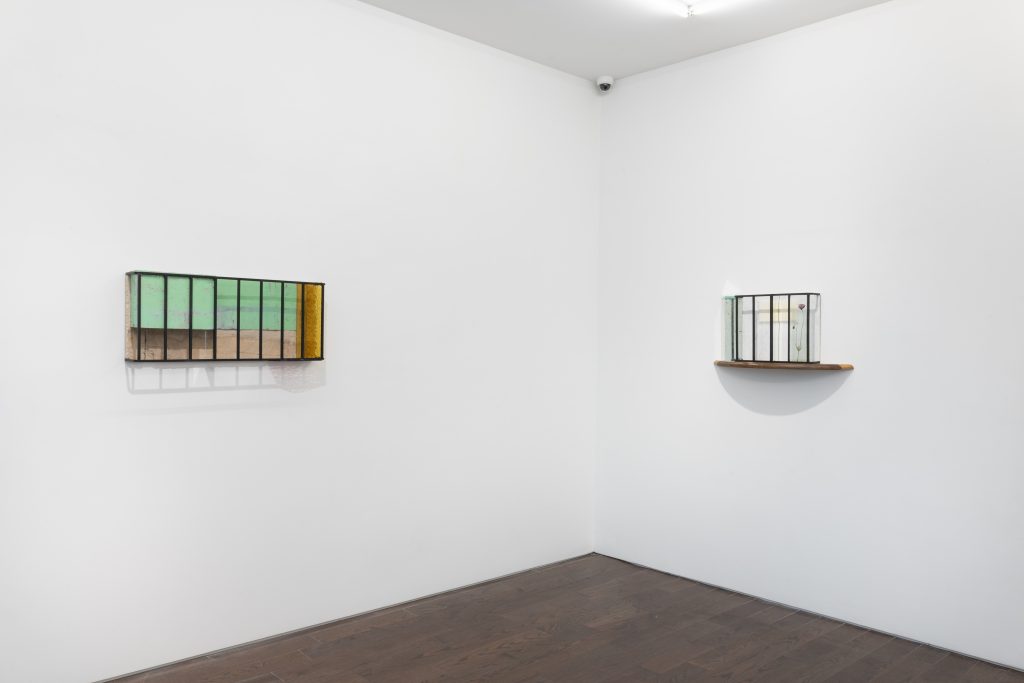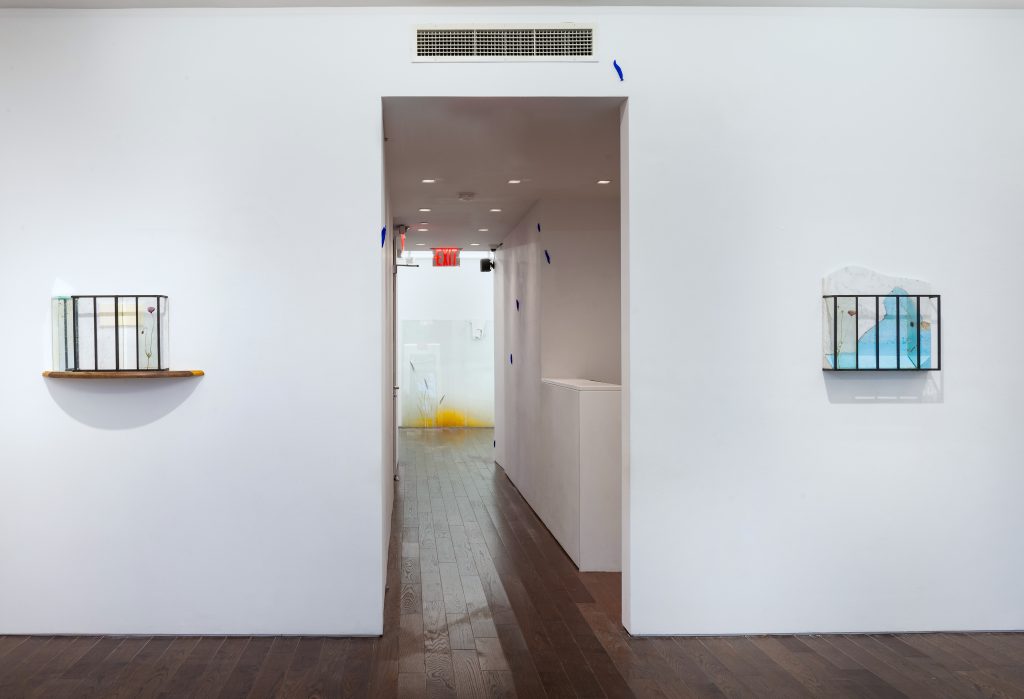The art of Wilfrid Almendra included in the new, current exhibition “Lilac dust and poppy” at the art gallery Ceysson & Bénétière in New York City is an engaging, beautiful sight, sculpting a vision of continuance from textures of decay. It’s striking, poignant, and memorable.
Wilfrid Almendra at Ceysson & Bénétière
Almendra’s artistic work, at least as spotlighted here, is largely sculptural, incorporating materials including steel, glass, and marble in gently progressing assemblages of form that are often on the smaller side.
Appearing expressive in form rather than an obvious capture of any real-world environment, Almendra’s artworks still recall, specifically, architecture, in both its more personal incarnations and experiences — like those of the inside of a house — and something more sweeping and oriented towards community, like a highly traveled street. The art hearkens towards massive ambition — but it’s something you can much more easily hold.
I got those feelings from both the specific materials that Almendra utilized — which are often associated with functional architecture — and the forms by which he assembled them, moving through each piece with an assertive but gentle sweep. In synchronicity with rigid structuring, Almendra’s art unfurls a space for rest and contemplation of the overarching — which feels naturally drawn from what he’s incorporating.
You feel like this kind of one-on-one encounter with our constructed and natural environments fits easily with the nature of those backdrops, as Almendra’s art is smooth and internally assured all the way down — even if that’s all something that we don’t always recognize or embark down in daily life. But it’s an inward illumination in this art on display, shimmering in its delicate grace. Real potential remains and awaits.
The grandiose, though hinted at, was made subdued and intimate, bringing out a facet of looming, encircling, internally weighted structure and sculpture where even that itself — as much as it might suggest, implicitly or explicitly, that it’ll be there indefinitely — is vulnerable, whether to erosion or a more purposed degradation. You see, clearly, that vulnerability.
Though not function-oriented, each perceptible form in Almendra’s artworks feels wholly realized before he moves to the next, and they collectively sit together with the materials’ and forms’ internal weight still palpable while a smooth gentility takes over. Glass, marble, and skeletal, steel framing coexist, with the glass — and the growing stillness of the forms the other materials take — imparting light and air from beneath to the artistic constructions and their experiences.

Several of Almendra’s pieces specifically conjoined rectangularly oriented steel bars with accompanying glass and other materials — a window of sorts, offering both enclosure and promise.
You felt an individualized sense of looking, set against the backdrop of forms that hearkened towards structures much, much larger — and those environmental forms were essentially looking right back, setting up a conversation and interchange in these pieces between the person experiencing the environment and that environment itself as it sprawls outwards from your gaze. These forms were quietly waiting, even beckoning for your engagement.
The intermixing of tension (some of the glass appeared broken) with peaceful, overarching forms — peaceful in part due to the relatively small scale that Almendra chose for some of the work — made things feel monumental, in a memorial sense: a narrative of remembrance mixing into something that’s lasting and secure in its present. The fleeting and momentary was combined with something that felt, even if steeped in vulnerability and precarity, at least still, like an isolated, woodland lake, offering a chance for reflection and interchange in the moment.

Structural Vulnerability and Rebuilding, Together
The art found stability from what looked at times like a lack of it, rebuilding — in a new, quieter way — in the face of disrepair.
The composite forms and materials struck me as fleeting in their relative isolation, and Almendra also included actual organic material (like a dried flower) at times, heightening this facet of the work.
Those moments of experiential fullness — like that of completed architecture — feel vulnerable from the get-go, considering the enclosing nature of some of Almendra’s sculptural forms making the surrounding, empty space feel especially like part of each artwork’s fuller context. In Almendra’s handling, there is — literally and in terms of aesthetic impact — a feeling of space within space, of both potential and the expression of that potential growing from within a structured enclosure.
Almendra was moving glimpses of space itself through machinations of memory and regrowth, as flickers of broader, earlier structures broke off and became something new.
Even with glass itself, as a material, we know it as something fragile and vulnerable to breaking, and Almendra holds it back from fully filling the steel bar-defined space he presents. We start seeing, from whatever point that we visually first land on the artwork, beyond those promises — invoked architecturally or aesthetically — of something formally pristine, but Almendra’s artwork still puts forward reassurance in place of that ideal that slips away, whether via storm-battered infrastructure, time-worn roads, or something that’s similar.
I imagine these artworks as shrines-of-sorts, perhaps along the side of a conceptual road, left there by an unknown creator and possibly added to by later visitors — or perhaps just the accumulation of less intentional energies and instead the blending of cast off materials into moments where recognition can persist.
Almendra’s exhibition “Lilac dust and poppy” continues through December 14 at Ceysson & Bénétière.

Featured image: same image and caption as are featured immediately above
You may also like
-
Diana Kurz at Lincoln Glenn in New York: A Review of a Shining Art Exhibition
-
Dustin Hodges at 15 Orient in New York City: An Ensnaring Exhibition at an Exciting Gallery
-
Maren Hassinger at Susan Inglett Gallery in New York: Reviewing an Uplifting Art Exhibition
-
Enzo Shalom at Bortolami in New York City: Reviewing an Entrancing Exhibition of Paintings
-
“Ben Werther: Townworld” at Amanita in New York City: Reviewing a Richly Memorable Art Exhibition